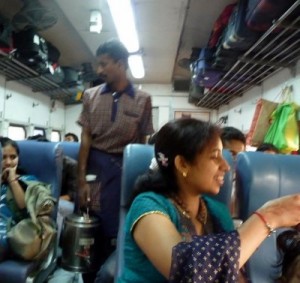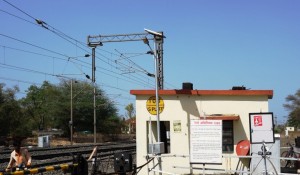Has Solar Power taken off to drive transport sector in future?
Most of the modules for tapping using solar power available in the market have been developed for a wide range of applications in Industry, residential and office complex. These modules may not immediately suit the Railways need for a few specific applications. It is, therefore, necessary to find the economic usage of the solar energy specific to resources and utility of Railways, and then have the modules developed for the purpose.
Selected data of power consumption of Indian Railways during the year 2013-14
- Indian Railway consumed 17.5 Billion units of energy of which 15 billion (Rs. 9650 Cr.) for traction and balance for non-traction (1650 Crs.). The peak demand is 4000 MW.
- The average cost of power had been Rs. 6.50 per unit ranging from Rs. 4.11 to Rs. 8.38 per unit.
- Established a company called Railway Energy Management Company (REMC) a JV of RITES and MoR with the mandated activity of harnessing green energy
- Indian Railway plans to target 10% of peak demand to target through renewable sources of energy by 2020.
- Indian Railway solar mission plans 1000 MWp in next five years, under PPP, through viability gap funding support from MNRE
- The locations are being selected based on the states where the tariff is very high such as Maharashtra, AP, Punjab, West Bengal, DVC, Tamil Naidu etc.
Prioritisation of renewable energy on the basis of economic viability
With the sharp falling prices of solar modules, the grid-connected module is getting popular but it is important for the IR to prioritize its resources in prioritizing the utility of funds. The priority identification is based on the most economic conversion of solar energy to the purpose and is as follows:
- Solar Hybrid Geyser provides service for direct usage of solar energy without converting it into electrical energy such as water heating, cooking, environment heating during winter etc.
- The solar panel converts solar energy into DC energy through the photo-voltaic cell and its direct usage for battery charging and DC bus. Railways use electric energy for battery charging of its coaches and maintaining DC bus for IT works.
- Power is utilized at the very instant without a need for storage. This is also called grid-connected power supply when it supplements the power need at an installation during day time and reduces day time demand.
- The stand-alone system in which Solar energy generated is either utilized during day time or stored in a battery to feed during night-time.
Solar Hybrid Geyser, cooking and distilled water plants
The primary source is solar and supplemented by electric energy to take care of exigencies of high temperature, night-time, and cloudy weather etc. Funds earmarked for renewable sources of energy shall first be prioritized in these areas. Use of electrical energy for these purposes itself is energy inefficient option, therefore, it makes solar water heater financial viable with payback period ranging from 2-5 years depending upon the region selected. The first prioritized action plan of Indian Railways shall be
- Provision of solar geyser in 24×7 hrs working or full occupancy installations such as Loco staff Running Rooms, Hospital, Canteens, Training Centers etc. shall fully be covered. A large number of such installations have already been covered and is in the first priority to cover the balance one. During extreme winters it may not be possible to get the desired output temperature from the solar geyser, but even raising the ambient, saves on energy. The solar mission shall first start counting in the reverse order the number left to be converted to the hybrid configuration.
- Provision of solar panels on the roof of the coaches of allShatabadi and Rajdhani type trains to supply pre-heated water to electric boilers. Electric boilers are installed in each coach and pantry car for the supply of hot water for preparation of tea. The cost of energy for water heating in such trains is very high of not less than Rs. 10-12/unit. For energy managers of Indian Railways, it is important to calculate the energy consumed for serving tea on EOG trains, than only the viability of this feature will find commitment towards implementation.
- With the use of VRLA type battery, the need for distilled water has reduced considerably. However, if there is any, solar distilled water plants shall be installed.
Solar Modules to charge the battery of the coach and DC bus for IT
Railway coaches are fitted with a battery which is pre-charged during maintenance and later by an underslung mounted alternator during a run. Pre-charging during maintenance is done by a utility power supply through a rectifier. Solar modules are best suited to provide this service without the need for inverter and storage battery.
- Provide solar panel modules at the roof of the washing lines which feeds the power to the charging line at about 130 V DC.
- Provide solar panels on the roof of the coach to directly charge the storage battery mounted underslung at each coach. There are many doubts about the viability and applicability of such provisions. Nowhere in any of the railways’ world over, self-generating coaches are in service, therefore, there is no possibility of getting the ready-made technology from abroad and has to be tried and developed in India only. The developed countries are already experimenting with the use of solar power for road vehicle and aircraft, which gives confidence for its viability. The coaches suitable for this purpose are
- Narrow and meter gauze TL coaches to be provided with roof-mounted solar panels to charge the battery removing self-generating units.
- Dedicated BG passenger coaches working in a closed circuit shall also be considered for the purpose. Bendable solar panels which can be pasted on the coach roof without affecting maximum moving dimension will serve the purpose.
- Indian Railways has entered into a contract with IIT/Chennai for development of solar module installed on the coach roof to power the lighting load. http://timesofindia.indiatimes.com/india/Railways-IIT-Madras-tie-up-to-power-AC-coaches-with-solar-energy/articleshow/21608984.cms. The progress and outcome of the study is not yet known.
- Northern Railway has experimented provision of the solar module on narrow gauze coach working onPathankot-Joginder Nagar section.
Grid connected Power supply
The power supply generated through the solar module is directly fed to the load and balance to the grid without storing in the battery. There are many options of using this power to connect daytime load which is quite significant in maintenance depots, workshop, and buildings with a corridor in center, hospital etc. Electricity Regulatory Commission of many states has permitted reverse metering so that excess energy generated is made use making the project viable.
With the solar panel cost coming down every year from the level of 76.76$/Watt in 1976 to 0.36$/Watt in 2014. In terms of rupees, it is Rs. 700 to Rs. 21 during this period. This has made solar power an attractive proposition and searches for vacant land, rooftop etc. has begun. In fact, the prices crashed in the first 18 years to 8$/watt due to technological development and its wide application for the purposes of power need which otherwise not possible. The development of inverter technology and its prices also crashing with time, the two together has now come forward to offer a solution to generate electric power almost at the same rate as that of the power generating sources such as thermal, hydro, nuclear, gas etc. which dominated this field.
Solar power and Transportation
Indian Railways is having a large area of unused and wasteland resource which can be utilized for the solar mission. The railway station rooftop is another area where the power generated is having captive utilization without requiring any transmission network. With this being the resource available, IR has made a very optimistic plan of 1000 MWp power generation and with REMC, a JV with RITES, it is expected that the things will show results very soon. The day is not far when solar power will be the driving force toward transportation.
Delhi Metro Railway Corporation has taken a lead in this field since October 2012, when an MOU is signed with GIZ to survey stations and depots ( namely Dwarka Sector 21 station, Yamuna Bank Depot, and station) and recommend for the viability of solar power plants. There are two models namely CAPEX and RESCO.
- CAPEX Model: Entire cost of the project is borne by DMRC i.e. about 70% and balance 30% subsidy from SECI/MNRE
- RESCO Model: RESCO or called Renewable Energy Service Company are developers identified by SECI. The developer will enter into a long term PPA for 25 years ( life of the plant) at a mutually agreed tariff. 30% subsidy to the developer will be paid by SECI. There is no capital expenditure to DMRC except permitting the use of roof of the station or wherever available.
- DMRC selected RESCO model for the purpose
- There are four PPAs finalized by DMRC of which one at Dwaraka of 500 kWp is already working at a levelised tariff of Rs. 6.94/- unit for a period of 25 years. The other three of 250, 1500 and 250 kWp has also been finalised at a leveled tariff of Rs. 6, 6.73 and 5.84/- respectively. There are also report that very recently contracts have been finalized at a rate around Rs. 5/- unit.

Avoid using solar energy for inefficient uses
Meeting targets is one of the main goals in any organization and the use of solar energy is no exception. Never use solar illumination system when the utility power supply is available. A picture below demonstrates where solar lighting is fitted at a level crossing gate located to a railway station having an auxiliary transformer installed to tap the traction power supply. The stand-alone solar power supply shall only be considered where the load is generally very low for illumination etc and installation power transport network is high such as
- Garden lighting
- Hilly area with scattered residential huts
- Manned non-interlock level crossing in between stations
Maintenance Issues
Solar modules are maintenance free with a very long life of more than 30 years (scitizen.com). But this is not so with accessories which constitute about 30% of the cost. The accessories are not maintenance free. The accessories are water pump, pipeline, insulation for solar geyser and battery, a current controller for solar lights and require maintenance. It is, therefore, important to go for maintenance contract cost inbuilt with the project cost and financial viability worked out accordingly.
What should be the strategy of rail transport to reduce cost of electricity burden
1. Indian Railways shall identify all locations where electricity is used for heating water and cooking and prohibits with time bound program to replace it with solar modules.
2. Identify land and roof suitable for solar power generation and invite tenders under RESCO model as done by DMRC. The cost of solar panel will further come down within a year or two. It is certain that IR will be able to enter long-term Power Purchase Agreement at a fixed rate which is prevailing at present.
3. The station roof shall be designed at the beginning itself to join mounting fixtures for solar panels. The gestation period of solar module power project is just 3 months and therefore, if the roof is designed to suit such requirement, it simplify the path towards solar mission.
4. To revive the project of installation of solar modules on the coach roof of trains which are working on dedicated path, day time and plying on north-south axis.


